
 The newsletter of NASA's Radio JOVE Project
The newsletter of NASA's Radio JOVE Project"Solar and Planetary Radio Astronomy for Schools"

 The newsletter of NASA's Radio JOVE Project
The newsletter of NASA's Radio JOVE Project
For this season we continue to publish prediction tables for many time zones around the world. Please go to the website http://radiojove.gsfc.nasa.gov/observing/predictions.htm to access the new predictions. Note that there are no significant Jupiter radio storms for December 2005, and thus the official season of observing begins in January 2006.
Here is a sample of the new prediction table for Central Standard Time Zone:
Date Day CST (UT-6) UT Storm Hour Angle
Dec No significant storms in December 2005
Jan 5 Thu 02:55 - 05:25 08:55 - 11:25 Io-A -5.0 to -2.0
Jan 6 Fri 05:40 - 07:30 11:40 - 13:30 Io-B -2.2 to -0.4
Jan 12 Thu 03:40 - 07:30 09:40 - 13:30 Io-A/C -3.9 to 0.0
Jan 13 Fri 06:25 - 07:30 12:25 - 13:30 Io-B -1.1 to 0.0
These prediction tables work best for mid-latitude locations in the U.S. If you live outside these areas the best way to create prediction tables for your location is by using Radio Jupiter Pro software from Radio-Sky Publishing. They have a free version created especially for Radio JOVE members and it can be downloaded for free at: http://radiojove.gsfc.nasa.gov/dal/software.htm.
Each line in the table has the date and day of the week, the local time to observe the predicted Jupiter storm, and the type of storm. We also include the Universal Time for those who prefer it. In the last column we include the Hour Angle of Jupiter during the duration of the storm. The Hour Angle is simple: it is the approximate location of Jupiter in the sky relative to your local meridian line (your meridian is the North-South line that divides the sky in half). We measure the Hour Angle from -6 hours (the object is rising) to +6 hours (the object is setting) with an Hour Angle equal to 0 when the object is on your meridian (also called transit).
Remember that this year Jupiter will be getting lower in the northern hemisphere skies. This means that people living at latitudes greater than about 10° North will need to use a phasing cable to make their antennas more sensitive to the southern skies. If you have trouble receiving Jupiter, perhaps you can join our live Jupiter data stream online via our permanent telescopes at the University of Florida and University of Hawaii-Windward Community College. Please see the Radio JOVE homepage for links to these observatories. We also cannot forget about the Sun! It continues to show some good activity when there are sunspots visible.
We plan to continue our coordinated observing sessions for the 2006 observing season. These are a targeted list of Jupiter and solar radio storms with high probability of observing success. Observers can interact via a toll-free tele-conference or use the online chat capabilities using Skypipe software. Please look for future emails and/or information on the Radio JOVE website about upcoming coordinated observing.
Good luck with your observations this season!
The Internet Jupiter Radio Observatory (IJRO, http://jupiter.kochi-ct.jp/) started on November 2002. IJRO is a joint project of the Kochi College of Technology with NASA's Radio JOVE outreach program (http://radiojove.gsfc.nasa.gov/). IJRO provides a real time data display on the Internet of Jupiter's decametric radio emissions observed at the University of Florida Radio Observatory (UFRO). The data consists of the intensities of three different observing frequencies (18, 20, 22MHz) with both right and left hand polarization components.
The main antennas used at UFRO for monitoring Jupiter's decametric emission are two arrays of conical log spiral elements. Each array has eight elements; one array is right-hand and the other left-hand circularly polarized. The online strip chart with 6 channel colored pens is refreshed anywhere from every three seconds to every 60 seconds depending on the choice of the user. We also stream over the Internet an audio channel from the 20 MHz right-hand polarized system.
The website of IJRO also has a link to the "Jupiter Radio CG Gallery" (http://jupiter.kochi-ct.jp/cg/). This gallery has unique computer graphics depicting Jupiter's radio emissions. Please visit our IJRO website.
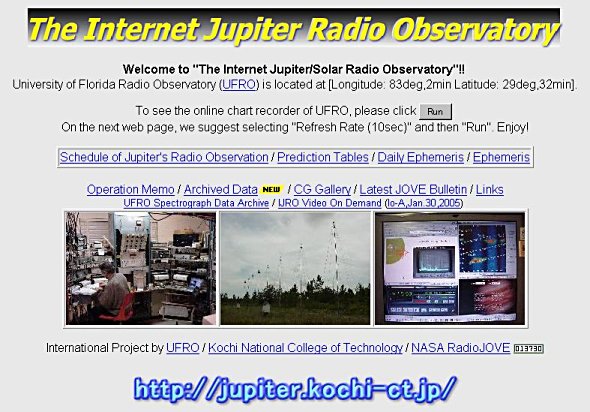
From the beginning, the Jove program has emphasized observations of signals from Jupiter. In fact, the Jove dual dipole antenna array was designed for this purpose. Over the years many observing teams have also monitored solar radio bursts using the Jove receiver and antenna kit. Schools in particular may benefit from daytime solar observations, which are easier for many students than nighttime observations of Jupiter.
Solar radio bursts are often much stronger than Jupiter bursts and so it is possible to receive them using a single dipole antenna at a height of 10 ft. With this in mind we will soon publish construction details on the Website for a single dipole Sun antenna. Some schools may find it easier to start out with a single dipole and observe the Sun. Later they can complete the Jove dual dipole antenna and observe both the Sun and Jupiter.
While Jupiter emissions may be weaker, they are more predictable than solar bursts. Given that we are moving toward sunspot minimum it will require a bit of patience and probably a few weeks of observations before observing any activity. Pay attention to the Jove listserve, as message traffic increases each time solar bursts are received. Despite the decline in sunspot activity Jove observers have had good luck in recent months. It will be interesting to measure the occurrence of solar bursts through the minimum and then into the upward swing of the next solar cycle. All observations are useful and we encourage you to submit your records to the Jove Archive http://jovearchive.gsfc.nasa.gov. Checkout sunspot activity on http://www.spaceweather.com/.
The Radio JOVE project is intended not only to give experience in radio astronomy, but also in the general methods of doing science. One important aspect of science is communication among investigators so that the community as a whole can build on the experiences and discoveries that each are making. Communication is the key word. In Radio JOVE this sharing of knowledge and experiences takes several forms. Communication can take place in real time while observations are taking place by joining the periodic toll free teleconferences during coordinated observing sessions or by using the built-in chat window capability in the Radio Skypipe software. We also try to encourage observers to put a copy of their charts, sounds, or Radio Skypipe data in the Radio JOVE archive (http://jovearchive.gsfc.nasa.gov) when they have something they believe will be of benefit to the community. Finally, probably the most familiar form of communication among Radio JOVE participants is the stream of email information that is exchanged through the radiojove email listserv. These messages can be alerts of activity taking place in near real time, comparisons of observations of storms by different observers, plans for future coordinated observing sessions, results of recent observing and unusual events, general communications with information of interest, etc.
Some of our Radio JOVE participants have been concerned that they are getting large numbers of email messages, especially at times when the Sun or Jupiter are active. There have also been occasional periods when the email exchanges concern discussions of problems or activities of interest. Some of these exchanges are very technical in nature and might not be understood by our beginning observers. It has been suggested that we have a separate email distribution list, to be called "jovetalk", for the more technically-oriented email exchanges, as well as general discussions between Radio JOVE participants.
When people join the Radio JOVE project they would be automatically subscribed to the project announcement email list, radiojove@listserv.gsfc.nasa.gov. This radiojove list would be changed so that only project team members of the project management team and perhaps selected semi-professional observers could post messages to this list. Newly joining Radio JOVE participants would be asked if they wish to subscribe to the jovetalk@listserv.gsfc.nasa.gov list for the more technical messages and for general discussions that they can join. Likewise, those presently subscribed to the radiojove@listserv.gsfc.nasa.gov list would also be asked if they wish to subscribe to jovetalk@listserv.gsfc.nasa.gov. The management group will post notices or transfer messages from the jovetalk list to the radiojove list when they are judged to be of importance for all participants. If there are any concerns about this plan please send your concerns to our management group at rj_project@radiojove.gsfc.nasa.gov. If there are no major objections we will implement this approach in the new year.
Nearly 50 people responded to our recent survey for the Radio JOVE project. Based on their responses, our team is planning improvements to the project. Here are the basic results from the survey:
Thanks to everyone who took the time to complete our survey. We had Educators, Students, Amateur Scientists, Hobbyists, Professional Scientists/Engineers, and Artists respond to our questionnaire. We wanted to give you a summary of the excellent feedback, because this allows us to better plan for the future and to continue to try to improve the kit hardware and software.
Over 830 Jove receiver and antenna kits have been distributed to observers around the world. We believe that most of these kits were built successfully and are currently in use.
Our recent survey included questions about the receiver, and improvements which users would like to see. A few folks mentioned that they have had difficulty making solar observations because of a strong interfering station that cannot be tuned out. A filter is available which has proven to be very effective in eliminating this interfering station. The filter is installed between the antenna and receiver.
Other observers were interested in having a calibrated noise source so that they could measure the galactic background and the strength of solar and Jovian radio bursts. Both the filter and a calibrator are available from RF Associates (rf@hawaii.rr.com).
Several respondents to the survey indicated that they would be interested in a pre-built Jove receiver. The Jove receiver is now available both as a kit, and also in a pre-built, tested and ready to go form. Check out the order section of the Jove website for details.
We want to be sure that your kit building experience is successful. Members of the Jove team are available to help via e-mail (see the Master Helpers list). If we can't help you fix it via e-mail, then your receiver can be repaired and aligned by RF Associates for a flat fee of $25 plus shipping.
On the pleasant autumn Sunday afternoon of 23 October, members of the Charlottesville Astronomical Society supported the National Radio Astronomy Observatory's open house on the campus of the University of Virginia. As part of the outdoor activities, I set up and operated a RadioJove dual-dipole rig to monitor solar activity. I also passed out a number of RJ info sheets to visitors. Several members of the NRAO staff showed interest in the RJ project.
A great and unexpected surprise was a visit from David Jansky, the son of Radio Astronomy's pioneer, Karl Jansky. He is on the left in the photo, talking to me near the RJ display. He liked the idea of continuing amateur activities, like RadioJOVE. He also shared some memories. As a kid he used to play on the "merry- go- round" base of his dad's old antenna. For perspective, Karl Jansky was only 23 years old and fresh out of school on his first professional assignment when, through careful observation and analysis, he determined that our galaxy was a source of radio emissions.
The picture also shows a square loop of red wire. This is a simple low frequency electrophonic detector that provided a nice audio background of 'SFERICS. Much like the GSFC INSPIRE Project. But that's another story.
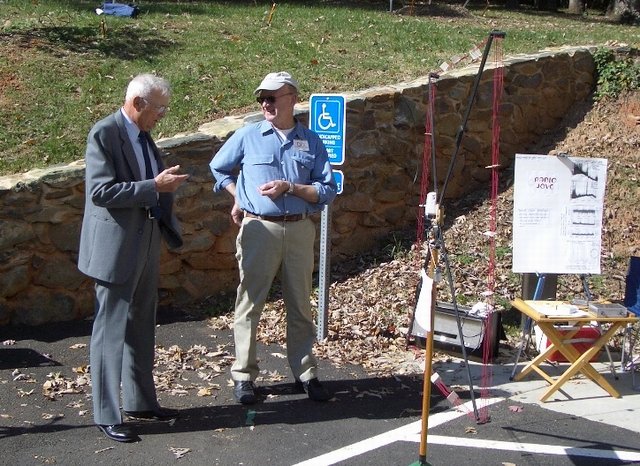
The Warren Rupp Observatory (WRO) held its annual Hidden Hollow Star Party south of Mansfield, Ohio on the weekend of September 30, 2005. The observatory is one of the largest optical telescopes ever to be run by amateur astronomers. The Rupp scope, also known as the "Big Blue Beast", is a 31 inch Newtonian reflector sitting inside a large aluminum dome.
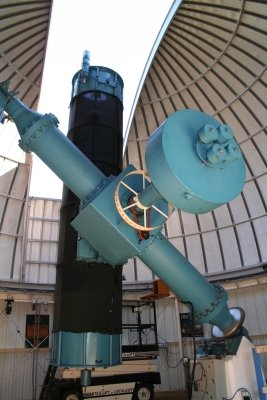
The telescope is so tall that a motorized lift is required to peer into the eyepiece. The Richland Astronomical Society (RAS) is the amateur organization responsible for the facility's care and operation. The society also holds public outreach programs at the observatory once each month.
I was invited to do a presentation on the Radio Jove project by Tammy Plotner, the WRO observatory director. Tammy is also a subscriber to the Jove e-mail list and is currently working to bring the Radio Jove project to WRO.
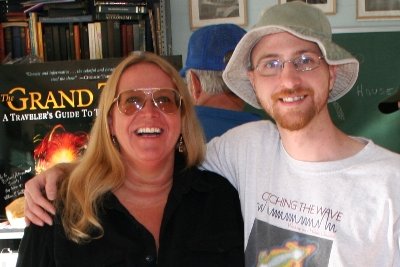
My Jove presentation was given on Saturday, October 1 at 11:30 am. In addition to the presentation I ran the power point kiosk developed to showcase samples of radio noise and demonstrate SkyPipe. Live solar observations had been planed but the sun was not cooperative. The kiosk was set up in one of the lodges near the observatory along with flyers containing informative links to resources on Radio Jove and decametric radio astronomy. Amateur astronomers, in particular those with Ham Radio experience, were attracted to the reasonable price and simplicity of observing the radio cosmos using the Jove setup.
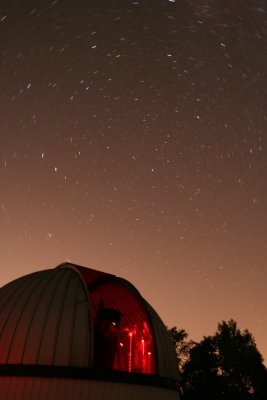
Hopefully the next few years will bring better opportunities to do live observations at Hidden Hollow.
LINKS:
The Warren Rupp Observatory http://www.wro.org/
The Astronomy Club of Akron http://www.acaoh.org/
The Windward Community College Radio Observatory (WCCRO) continues to operate 24/7, streaming SkyPipe, spectrograph data, audio, and Java enabled stripcharts. Power line interference, seen as diagonal bands on the radio spectrograms continues to be an intermittent problem.
To connect to our audio stream simply enter http://166.122.43.79:9000 into Microsoft Media Player (or other similar program).
Our radio equipment will soon be moved to the new observatory building. The builidng is almost finished - a bit of interior work and painting remains before the equipment can be moved.
WCCRO will continue as a testbed for improving the Jove spectrographs (located here in Hawaii and in Florida at UFRO). New software is being tested to enable archiving of scheduled observations such as Io-related Jupiter emissions.
The University of Florida Radio Observatory (UFRO) is beginning to get back on line after the shut down of most of the equipment to avoid lightning damage during the summer.
The radio link connecting UFRO with the Univ. of Florida campus has been reconnected and is active. We were fortunate that the preamps located at the top of the towers didn't suffer damage during the lightning season and everything is working.
The two TP arrays (left (LH) and right hand (RH) circularly polarized) have been phased to -20 degrees declination so that their beam points to Jupiter's declination during the 2006 observing season. The sun will be also transit in the beam of the arrays during December 2005 and January 2006.
At the present we are streaming data from the 18, 20, and 22 MHz TP receivers (Both RH and LH circularly polarized components) and the 20 MHz RJ receiver, to the Internet Jupiter Radio Observatory (IJRO) in Kochi, Japan (http://jupiter.kochi-ct.jp). We are also providing on-line access to the UFRO radio spectrograph data display (18-28 MHz).
Thanks to a grant from the Florida Space Grant Consortium, we have been able to purchase a new computer for the audio streaming and will be able to replace the old one that failed at the end of last season. The computer is being configured and should be ready before the end of December. As we have been doing in the past seasons we will be streaming audio from the 20 MHz TP receiver, the 20 MHz RJ receiver, and the INSPIRE receiver through http://picasso.astro.ufl.edu:8000/ICY-1.
We have been working on the repairs of one of the LH polarized TP elements that came down during the 2004 hurricane season. Thanks to a grant from Middle Tennessee State University we were able to purchase a replacement mast and hardware to repair the fallen TP. We expect to have it working for the beginning of the Jupiter season in January. We will also replace the old, bigger plastic covers at the top of 12 of the TP elements by new, smaller and more durable ones. These plastic covers protect the transformer and coaxial cable from the rain and water condensation.
The UF Jupiter predictions for 2006 have been generated and will be available soon at the UFRO on-line website (http://UFRO1.astro.ufl.edu/decframe.htm).
There are three major pieces of software that we encourage Jove Project participants to use. Each of these programs is updated occasionally with improved features and bug fixes. With the new Jupiter season approaching it is a good idea to bring your software up to date and test the PC end of your system.
Radio-SkyPipe. This is the data collection tool used by most Jove Project observers. "SkyPipe", as it is commonly called, takes audio output from your receiver and produces a strip chart that can optionally be viewed across the internet. You can download a free version of this program. The paid "Pro" version allows you to record audio from your receiver onto your computer, replacing the tape recorder that was once suggested. If you already have Radio-SkyPipe, click on Help/SkyPipe News (you must be on line) to get the latest update info. You can always get to the most recent SkyPipe release on this web page: http://radiosky.com/skypipeishere.html
SkyPipe Tip: You can view simplified live SkyPipe charts via the WCCRO based SkyPipe Java server. This service is not available 100% of the time but when it is running it can be very handy for confirming that your data is getting out over the internet. If the Java Server is running and can log onto you , you will see it logged on as "Browser". Go to: http://166.122.43.81
Radio-Jupiter Pro is the program most of us use to predict the best times and antenna configurations for capturing Jupiter's noise storms. With Jupiter heading south in declination, new antenna configurations will be needed for northern hemisphere observers. A new release of Radio Jupiter Pro will provide the correct antenna patterns associated with these antenna configurations. Download the latest available version at: http://www.radiosky.com/rjpro3ishere.html
Spectrograph is a free, downloadable program that you can use to view the live radio spectrograph data streams from the WCCRO and UFRO observatories. If you have never tried it, you really should. This literally adds another dimension to your observing and provides you with greater insight into the way Jupiter and Solar radio bursts behave over a range of frequencies. Spotting actual bursts is much easier on the Spectrographs. This information can then be used to verify your own observations.http://jupiter.wcc.hawaii.edu/spectrograph_software.htm
The JOVE Bulletin is published twice a year. It is a free service of the Radio JOVE Project. We hope you will find it of value. Back issues are available on the Radio JOVE Project Web site, http://radiojove.gsfc.nasa.gov/
For assistance or information send inquiries to:
or
Email: rj_project@radiojove.gsfc.nasa.gov